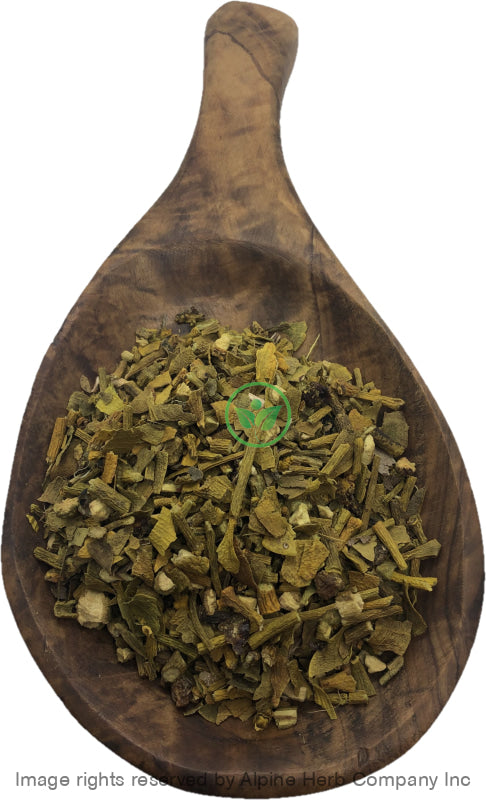Mistletoe Herb Cut Alpine Herb Company Inc.
$ 8,99 $ 5,39
Botanical Name: Viscum album
Common Name:
- English: European Mistletoe
- Also, known as: Mistel, Gui blanc, Liga, Olma, Banda, Visco quercino, Kishmish-j-kawaliyan, San-shang-chi-sheng, Birdlime Mistletoe, Herbe de la Croix, Mystyldene, Lignum Crucis
- Ayurvedic: Bandaaka, Suvarnabandaaka, Vrikshaadani
- Unani: Kishmish Kaabuli
Habitat: Native to Europe
Origin: Albania
Harvested: Wild
Parts Used: Leaves & stems
General Information:
Mistletoe is found throughout Europe, and in this country is particularly common in Herefordshire and Worcestershire. The well-known Mistletoe is an evergreen parasitic plant, growing on the branches of trees, where it forms pendent bushes, 2 to 5 feet in diameter. It will grow and has been found on almost any deciduous tree, preferring those with soft bark, and being, perhaps, commonest on old Apple trees, though it is frequently found on the Ash, Hawthorn, Lime and other trees. On the Oak, it grows very seldom. It has been found on the Cedar of Lebanon and on the Larch, but very rarely on the Pear tree.
The stem is yellowish and smooth, freely forked, separating when dead into bone-like joints. The leaves are tongue-shaped, broader towards the end, 1 to 3 inches long, very thick and leathery, of a dull yellow-green color, arranged in pairs, with very short footstalks. The flowers, small and inconspicuous, are arranged in threes, in close short spikes or clusters in the forks of the branches, and are of two varieties, the male and female occurring on different plants. Neither male nor female flowers have a corolla, the parts of the fructification springing from the yellowish calyx. They open in May. The fruit is a globular, smooth, white berry, ripening in December.
How to use:
Hot Infusion:
The basic method for dried herbs and flower is, take 2-3 tablespoons of dried herb in a cup or teapot. Pour hot water over it and cover it with lid for 10-30 minutes. Hot water is needed to draw out the antioxidants, enzymes, vitamins, flavonoids, and volatile oils from the botanicals. Strain and squeeze out as much as liquid as possible and enjoy!
Tips:
- You can sweeten your herbal tea with a bit of honey, natural fruit juice, stevia leaves powder and or licorice root powder.
- You can make ice cubes or pops by freezing tea in ice trays or pop molds.
Precautions:
You should consult with a qualified healthcare practitioner before using any herbal products, particularly if you are pregnant, nursing, or on any medications.
All information on this website is for educational purposes ONLY.
This information has not been evaluated by Health Canada.
This information is not intended to diagnose, treat, cure, or prevent any disease.
| Unit Size | 100g, 200g, 400g, 1kg |
|---|
Prompt shipping and expert packing
Thanks to our longstanding association with UPS FedEx DHL as well as other leading global carriers, we can offer a variety shipping options. Our warehouse staff is highly trained and will be able to pack your goods in accordance with our precise and exact specifications. Your items will go through an exhaustive examination before they will be securely packaged before being delivered. We ship to hundreds of thousands of customers daily in different countries. This is a sign of our determination to become the largest online retailer worldwide. Warehouses and distribution centers are located throughout Europe as well as in the USA.
Note that orders containing multiple items are processed according to the particular item.
We will thoroughly inspect all items ordered before shipping. Most orders are shipped within 48 hours. The delivery time will be between 3 and 7 working days.
Returns
The stock market is always changing. It's not entirely managed by us since we're involved with several entities, including the factory and the storage. Therefore, the actual inventory could fluctuate at any moment. Please be aware that it is possible that your order could be out of stock after you've placed your order.
Our policy lasts for 30 days. If it's been more than 30 days since the date you purchased your item We're sorry to say that we can't offer you a full exchange or refund.
You can only return a product if it is unused and still in the same state as when you received it. The item should be in the original packaging.


































